
Some Facts About Florida’s Genetically Modified Mosquitoes from an article in Entomology Today by Richard Levine
Empowering Georgia through UGA Extension

Some Facts About Florida’s Genetically Modified Mosquitoes from an article in Entomology Today by Richard Levine
It’s that time of year when those in mosquito surveillance and control think fondly of consistently cooler temperatures and eagerly await that first hard frost. Of course, this is already happening in some places up north. We may have to wait a while longer in here in Georgia. But that does bring to mind the question: Where do all the mosquitoes go once the colder weather arrives?
Mosquitoes, like all insects, are cold-blooded creatures. As a result, they are incapable of regulating body heat and their temperature is essentially the same as their surroundings. Mosquitoes function best at 80 F, become lethargic at 60 F, and cannot function below 50 F. In tropical areas, mosquitoes are active year round. In temperate climates, mosquitoes become inactive with the onset of cool weather and enter diapause (hibernation) to live through the winter. Diapause induction also requires a day length shorter than 12 hours light (more than 12 hours dark). All mosquitoes pass through four developmental stages: egg, larva, pupa and adult, and diapause can occur in any of these stages depending on the species.
What, if anything, does this mean for West Nile virus (WNV)? If the mosquitoes are infected with WNV when they enter diapause, it should overwinter with them to be transmitted to birds when the mosquitoes emerge the following spring. Temperature is the crucial factor in the amplification of the virus. Studies in various states have shown that WNV does indeed overwinter in mosquitoes. The virus does not replicate within the mosquito at lower temperatures, but is available to begin replication when temperatures increase. This corresponds with the beginning of the nesting period of birds and the presence of young birds. Circulation of virus in the bird populations allows the virus to amplify until sufficient virus is present in the mosquito populations (and vector mosquito populations are high enough) that horse and human infections begin to be detected.
In the Northeastern U.S., Culex pipiens, the northern house mosquito, is the most important vector species. This species overwinters as an adult, and has been found harboring WNV during the winter months. This mosquito goes into physiological diapauses (akin to hibernation) during the winter months, and while it may be active when temperatures get above 50°, it will not take a blood meal.
Culex quinquefasciatus, the southern house mosquito and the major vector for WNV in Georgia, also overwinters as an adult, and also goes into diapause when winter comes, and it is likely that this mosquito also harbors WNV throughout the winter months. However, the southern house mosquitoes go into more of a behavioral diapause when temperatures are below 50°, and are quite capable of taking a blood meal (and maybe transmitting WNV) when things warm up during the winter, which is not an unlikely occurrence here in Georgia especially as one goes further south. So, although the risk for WNV transmission in the south in the winter months is very low, it is certainly possible.
The return to school can mean an increase in cases of head lice. Children are more likely to get them than adults because children play and live so close together, especially at school and daycare. Dr. Paul Guillebeau and Gretchen Van De Mark, UGA Entomology Department, share valuable information in two publications on understanding and controlling head lice.
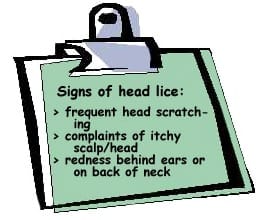 Do not panic! Head lice are not an emergency and, in most cases, do not pose any health risk. Misuse of pesticides, however, and use of unlabeled treatments (ex., kerosene) can pose a health risk.
Do not panic! Head lice are not an emergency and, in most cases, do not pose any health risk. Misuse of pesticides, however, and use of unlabeled treatments (ex., kerosene) can pose a health risk.
Head lice CANNOT live off a human host for more than 24-48 hours. Head lice CANNOT live on pets. Head lice CANNOT reproduce in carpets, furniture or other household furnishings.
PESTICIDE SPRAYS DO LITTLE OR NOTHING TO CONTROL LICE. NEVER treat homes, cars, furniture, beds, pillows or clothing with pesticides (e.g., ‘lice bombs,’ flea bombs, sprays, etc.) in an attempt to control head lice. You will expose yourself and others to unnecessary pesticide risk.
If your school sprays rooms, buses, furniture, etc., to control head lice, ask them to stop immediately. Refer your school to the Cooperative Extension Service brochure called A School’s Guide to the ‘Nitty-Gritty’ about Head Lice.
Head lice are very common among all classes of people. More than 12 million people, mostly children and school personnel, get head lice each year.
Direct head-to-head contact with an infested person is the main way head lice are transmitted, but they may also be transmitted by sharing hats, scarves, headphones, combs and other hair accessories. Lice cannot hop, jump or fly, but they can crawl rapidly.
The best treatment for head lice is manual removal (see ’10 Tips for Manual Removal’ in A Parent’s Guide to the ‘Nitty Gritty’ about Head Lice ).
If a lice shampoo is warranted, ask your doctor or pharmacist for specifics on the product and follow all label instructions exactly. Misapplications can be ineffective and dangerous as well.
See these UGA publications for more information on controlling head lice safely and effectively
A School’s Guide to the ‘Nitty-Gritty’ about Head Lice, Paul Guillebeau and Gretchen Van De Mark
A Parent’s Guide to the ‘Nitty-Gritty’ about Head Lice, Paul Guillebeau and Gretchen Van De Mark
Edited from the PROGRAM SPOTLIGHT section of the November 2013 issue of Dideebycha, the Georgia Mosquito Control Association newsletter.
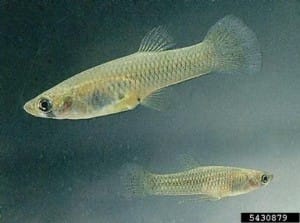
The mosquitofish program is a new venture for Richmond County Mosquito Control. Since there are always some pools that have to be in control maintenance due to an inability to determine who owns the pool, or other reasons, a means of reducing the cost of maintaining these pools was sought. Tiny fish could be the answer to some of the county’s biggest mosquito problems.
Mosquitofish fill Phinizy Swamp and now they also fill some abandoned swimming pools. It’s a new project with Richmond County Mosquito Control and the Southeastern Natural Sciences Academy and it could save residents a few bug bites.
Dr. Oscar Flite is the Vice President for Research at the Southeastern Natural Sciences Academy at Phinizy Swamp. They’ve teamed up with Richmond County mosquito control for an experiment with mosquito fish placing them in abandoned pools to stop mosquito’s from breeding there.
Earlier in the summer they added about 30 mosquito fish to 4 pools in the county. In two weeks they went back to check and see how the programs working. The fish had survived and were reproducing, and preliminary surveillance data show a decrease in numbers of mosquitoes being caught in traps set in the vicinity of the pools.
The mosquito fish will save both time and money. “It’s going to save us a lot of money because treating a pool three times a year costs us about 150 bucks,” explained Koehle.
“The guys spent about 5 minutes going out and catching more than a 150 mosquito fish, so in terms of economics I think it works out pretty well,” added Dr. Flite. An easy fix and easy to get rid of when someone wants to swim.
“When a new homeowner moves in, they dump the water out the fish go with it no big deal,” said Koehle
“Nobody loses, everybody wins in this.”
Well, everyone except the mosquitoes.
Taken from the April 10 issue of Dideebycha, newsletter of the Georgia Mosquito Control Association
Aedes albopictus was introduced into the Port of Houston in 1985 in shipments of used tires from northern Asia. Movement of tire casings has spread the species to more than 20 states since 1985.
The Asian tiger mosquito is a small black and white mosquito. The name “tiger mosquito” comes from its white and black color pattern. It has a white stripe running down the center of its head and back with white bands on the legs. These mosquitoes lay their eggs in water-filled natural and artificial containers like cavities in trees and old tires; they do not lay their eggs in ditches or marshes. The Asian tiger mosquito usually does not fly more than about ½ mile from its breeding site and generally flies a considerably shorter distance.
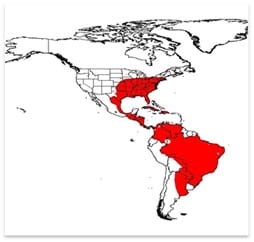
Aedes albopictus associates closely with people and is an aggressive, daytime biting mosquito. It is native to the tropical and subtropical areas of Southeast Asia, and is now found in 1/3 of the Unites States. New Jersey, southern New York, and Pennsylvania are currently the northernmost boundary of established Ae albopictus populations in the eastern United States.
The tiger mosquito is an important disease carrier in Asia. In North America, Ae albopictus is among the most efficient bridge vectors of WNV. In addition to vectoring exotic arboviruses, this species can also transmit the endemic eastern equine encephalitis and La Crosse viruses in the laboratory and in the field. It is a competent vector of both Dengue and Chikungunya virus. In fact, Ae albopictus is a competent vector for at least 22 arboviruses.
A lot of work has been done recently on control of Ae albopictus. Since it is a daytime biting species and an asynchronous emerger, conventional truck-based ULV spraying doesn’t always work well. According to one study, an integrated pest management approach can affect abundances, but labor-intensive, costly source reduction is not enough usually to maintain Ae albopictus counts below a nuisance threshold.
References
Fonseca, et al, Area-wide management of Aedes albopictus. Part 2: Gauging the efficacy of traditional integrated pest control measures against urban container mosquitoes. 2013. Pest Management Science, 69 (12): 1351–1361.
Nancy C. Hinkle, Ph.D.
Veterinary Entomologist, Dept. of Entomology, University of Georgia
One of the foundations of Integrated Pest Management is prevention, and one of the essential underpinnings of prevention can be regulatory restrictions. If we prevent the introduction of a pest or disease into an area where it does not occur, we avoid the risks associated with the pest or pathogen.
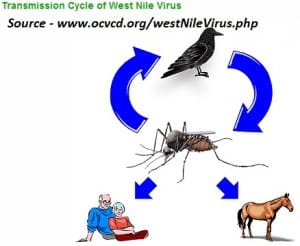 Up until fifteen years ago we had never had a case of West Nile Virus in the U.S. So how did West Nile Virus come to North America? Probably someone smuggled in an infected bird that was carrying the virus. The smuggler didn’t think he was doing anything bad; after all, he had paid good money for the bird and wanted to bring it home with him to New York City. What was wrong with tucking the bird into his pants and not declaring it when the agent asked if he was bringing any living animals as he passed through Customs? Once home, the bird was placed in a cage near the apartment window, a local mosquito flew in and sucked a little of its blood, then flew out and fed on a local sparrow. The sparrow became infected with West Nile Virus, more mosquitoes fed on it and picked up the virus, and a few weeks later dozens of birds at the Bronx Zoo dropped dead of West Nile Virus after being fed on by these infected mosquitoes.
Up until fifteen years ago we had never had a case of West Nile Virus in the U.S. So how did West Nile Virus come to North America? Probably someone smuggled in an infected bird that was carrying the virus. The smuggler didn’t think he was doing anything bad; after all, he had paid good money for the bird and wanted to bring it home with him to New York City. What was wrong with tucking the bird into his pants and not declaring it when the agent asked if he was bringing any living animals as he passed through Customs? Once home, the bird was placed in a cage near the apartment window, a local mosquito flew in and sucked a little of its blood, then flew out and fed on a local sparrow. The sparrow became infected with West Nile Virus, more mosquitoes fed on it and picked up the virus, and a few weeks later dozens of birds at the Bronx Zoo dropped dead of West Nile Virus after being fed on by these infected mosquitoes.
Meanwhile people in Queens were developing high fevers, severe headaches, and nerve problems like paralysis. Even though New York mobilized and started treating for mosquitoes, the virus was already established in birds and mosquitoes. West Nile did not exist in the U.S. prior to 1999; since that year mosquitoes have spread West Nile westward through the continental U.S., resulting in over 1,700 human deaths and ten times that many paralysis cases.
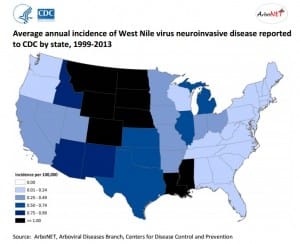
There is a reason the Customs Declaration Form that people entering the U.S. fill out contains the question, “Are you bringing with you meats, animals, or animal/wildlife products?” While we don’t often think about it, animals in other countries can contain pathogens that we don’t have here in North America and that can be lethal to humans or animal life on our continent. If these hosts get moved into our country, the pathogens can rapidly spread to local wildlife and then to humans.
Before traveling outside the U.S., travelers should visit the Centers for Disease Control website to determine which vaccinations and medications are needed for the areas to which they’ll be traveling. It’s important to follow appropriate precautions to avoid insect bites. And people reentering the U.S. should not bring back with them any living animal or plant, meat, or other animal products. The fellow who smuggled in the West Nile-infected bird had no idea that his action would result in the death of over 1,700 Americans, thousands of horses, and countless wild birds.
Answer: This study indicated that people in areas with no mosquito control program had a tenfold greater risk of WNV than those in areas where mosquitoes were controlled.
Read the entire article Using Mosquito Surveillance Data taken from the April 10, 2014 issue of Dideebycha, newsletter of the Georgia Mosquito Control Association
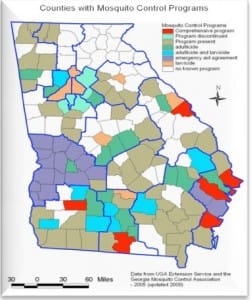 Mosquito surveillance is an important component of any mosquito control program. Where arboviral diseases occur, mosquito testing is an equally important component of an arboviral surveillance program. Arboviral encephalitis can be prevented in two major ways: personal protective measures to reduce contact with mosquitoes and public health measures to reduce the population of infected mosquitoes in the environment (mosquito control). Analysis of surveillance data provides information about the timing of arboviral transmission and the risk to the public, which can trigger county-level educational programs to help reduce risk.
Mosquito surveillance is an important component of any mosquito control program. Where arboviral diseases occur, mosquito testing is an equally important component of an arboviral surveillance program. Arboviral encephalitis can be prevented in two major ways: personal protective measures to reduce contact with mosquitoes and public health measures to reduce the population of infected mosquitoes in the environment (mosquito control). Analysis of surveillance data provides information about the timing of arboviral transmission and the risk to the public, which can trigger county-level educational programs to help reduce risk.
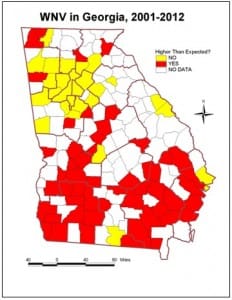
A study comparing two mosquito control districts showed that the program with the most mosquito surveillance and best documented larviciding and adulticiding operations had the fewest number of WNV cases. This study indicated that people in areas with no mosquito control program had a tenfold greater risk of WNV than those in areas where mosquitoes were controlled.
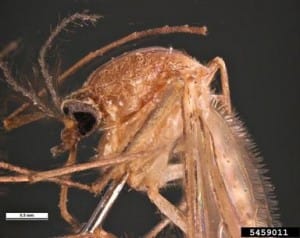
What are the roadblocks to arboviral surveillance in Georgia? We really do not have enough data to do good predictive calculating, particularly at the State level. Predicting where and when WNV outbreaks will occur is difficult, especially in areas with endemic transmission, which is what occurs in Georgia. Most of our sentinel data do not match up with our case data, as counties doing mosquito surveillance are not necessarily the same counties where human cases are occurring. Culex quinquefasciatus (Southern house mosquito), our primary WNV vector, are not evenly distributed, so neither is risk of human cases. However, we do not have sufficient surveillance to know where risk is occurring, and maintaining mosquito monitoring systems is costly even though it is essential according to the CDC.
Where data are available, the best predictor of risk is the Vector Index, the minimum infection rate (MIR) times the number of mosquitoes per trap night (abundance), which provides 2-4 weeks lead time in advance of human cases. Where adequate surveillance is maintained, this gives sufficient lead time to implement adult mosquito control efforts, which have demonstrated success in reducing human risk, resulting in fewer WNV cases (Carney, 2008).
Reference: Carney, R.M., Husted, S., Jean, C., Glaser, C., & Kramer, V. (2008). Efficacy of aerial spraying of mosquito adulticide in reducing incidence of West Nile Virus, California, 2005. Emerging Infectious Diseases, 14(5), 747–754.
Posted July 17, 2014 on the IPM in the South blog from the Southern Region IPM Center
The EPA unveiled a new graphic that will be available to appear on insect repellent product labels. The graphic will show consumers how many hours a product will repel mosquitoes and ticks when used as directed.
The EPA’s new graphic will do for bug repellents what SPF labeling did for sunscreens. This new graphic will help parents, hikers and the general public better protect themselves and their families from serious health threats caused by mosquitoes and ticks that carry debilitating diseases. Incidence of these diseases is on the rise. The CDC estimates that there are nearly 300,000 cases of Lyme disease in the United States each year. Effective insect repellents can protect against serious mosquito- and tick-borne diseases.
The EPA is accepting applications from manufacturers that wish to add the graphic to their repellent product labels. The public could see the graphic on products early next year.
Seven months after the mosquito-borne virus chikungunya was recognized in the Western Hemisphere, the first locally acquired case of the disease has surfaced in the continental United States. The case was reported today in Florida in a male who had not recently traveled outside the United States. The Centers for Disease Control and Prevention is working closely with the Florida Department of Health to investigate how the patient contracted the virus; CDC will also monitor for additional locally acquired U.S. cases in the coming weeks and months.
Reprinted from Entomology Today – Read the entire article here.
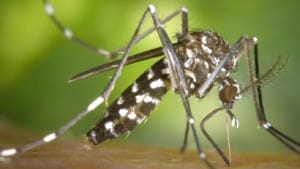 About six months ago, the U.S. Centers for Disease Control issued a travel warning for people visiting islands in the Caribbean because chikungunya virus had been detected on the island of St. Martin. This was the first time it had been detected in the Americas.
About six months ago, the U.S. Centers for Disease Control issued a travel warning for people visiting islands in the Caribbean because chikungunya virus had been detected on the island of St. Martin. This was the first time it had been detected in the Americas.
Now, in addition to the islands, health authorities are preparing for the virus to infect people in the U.S. itself.
“It’s not a matter of if, but when,” Dr. James Crowe, an infectious disease expert at Vanderbilt University, recently said to USA Today.
According to the National Association of County and City Health Officials (NACCHO), “it is virtually certain” that the virus will become established in the U.S. According to Paul Etkind, senior director for infectious diseases at NACCHO, “Local health departments should expect to see more of these cases as travel to the Caribbean for business and pleasure purposes increases over time. In addition, hundreds of thousands of soccer fans, many from the United States, are expected to travel to Brazil in July for the World Cup. The opportunities for introduction of the virus via infected fans returning from the games will be many.”